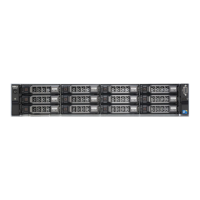from the tape backup to the original location; first, restore the data back to a DR Series system replica container, and
then restore it back to the original source location of the data on the other side of the WAN link.
NOTE: If you choose to use this alternate workaround method, you must set up a new data storage unit in the DMA
and import the images before a restore to the original location can occur.
To support this effort to leverage deduplication across the WAN to allow this scenario, complete the following:
1. Make sure that the replication operation has completed (between source and target).
2. Delete current replication relationship, and re-create replication relationship (reversing the source and target
roles).
3. Restore data to the original source container (now the target).
4. Make sure that the replication operation has completed.
5. Delete replication relationship and re-create replication relationship (restoring original source and target
destinations).
Under this scenario, a fraction of the data to be recovered is sent across the WAN link. This could speed up a remote
restore significantly. However, there are some downsides to this type of scenario:
• If step 1 is not followed correctly, any changes not fully replicated are lost.
• During steps 2 and 3, any data that is written to the original DR Series system source container may be lost.
• During step 4, if the data is not fully replicated back before the switch is made, it may be lost.
Alternatively, you still could support this effort by completing the following:
1. Create a new container on the target DR Series system.
2. Set up replication from this container back to the source DR Series system container.
3. Set up a new disk storage unit in the DMA and make sure that the DMA is aware of any new images.
4. Import the old images back into the DMA from the target DR Series system (the original source location).
5. Use a new disk storage unit in the DMA, and then restore the data back to the original client.
Data Deduplication and Compression
The DR Series system design uses various data-reduction technologies, including advanced deduplication algorithms, in
addition to the generic and custom compression solutions that prove effective across many differing file types. Data
deduplication and compression is addressed in the following areas:
• DR Series System — The DR Series system backup and recovery appliances provide both efficient and high-
performance disk-based data protection to leverage the advanced deduplication and compression capabilities in the
DR Series system software. The DR Series systems provide a key component that performs backup, recovery, and
data protection operations.
• Deduplication — This technology eliminates redundant copies of data and in the process it decreases disk capacity
requirements and reduces the bandwidth needed for data transfer. Deduplication can be a major asset for
companies that are dealing with increasing data volumes and require a means for optimizing their data protection.
• Compression — This technology reduces the size of data that is stored, protected, and transmitted. Compression
helps companies improve their backup and recovery times while helping reduce infrastructure and network
resource constraints.
In general, DR Series systems are disk-based data protection appliances that offer advanced deduplication and
compression capabilities to reduce the time and cost associated with backing up and restoring data. Based on
deduplication and compression technology, the DR Series systems eliminate the need to maintain multiple copies of the
same data. This lets customers keep more data online longer and reduce the need for tape backup dependency.
Using its deduplication and compression technology, DR Series systems can help achieve an expected data reduction
ratio of 15:1. Achieving this reduction in data means that you need fewer incremental storage operations to run and it
18

